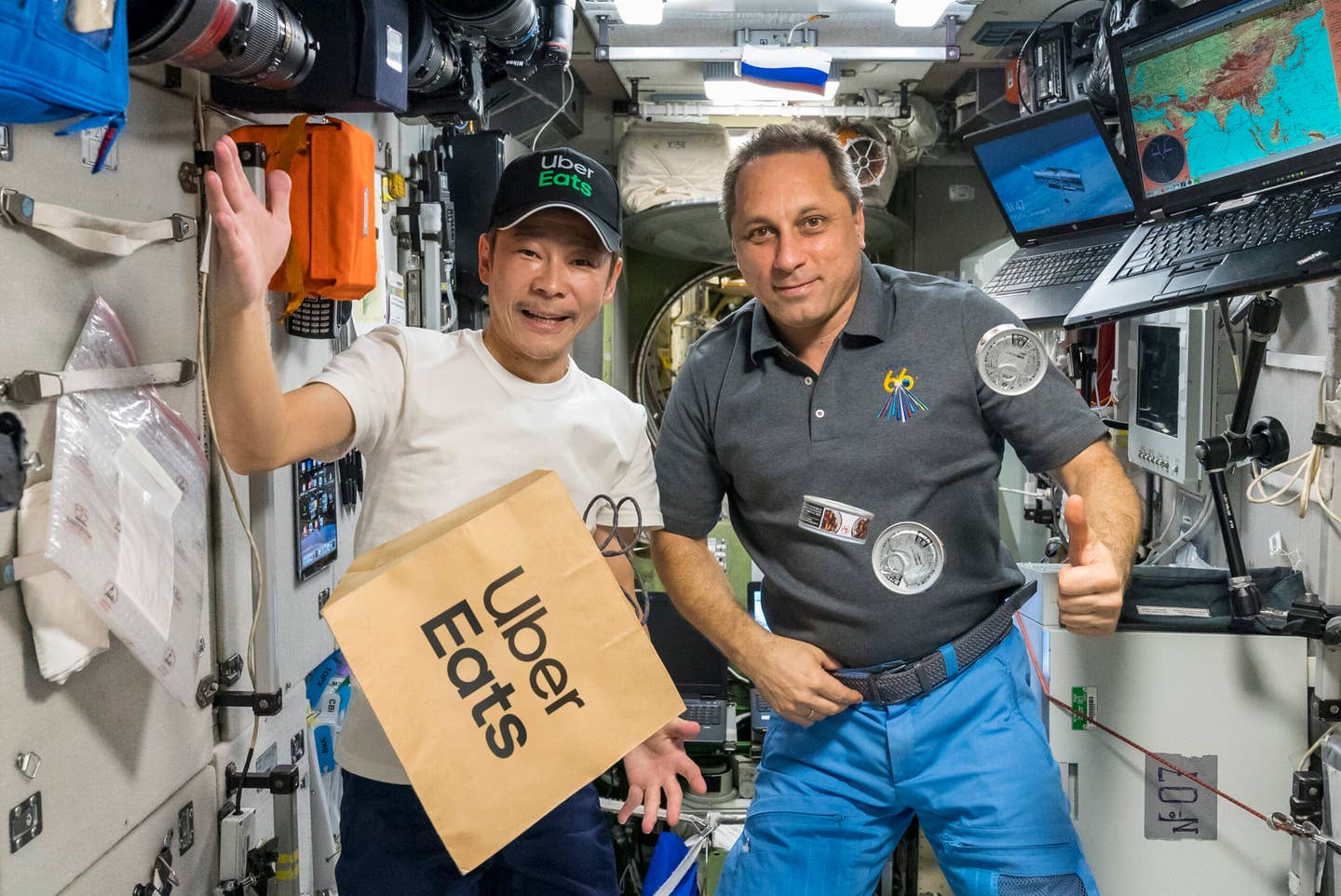The Five Weirdest Things Sent to Space
From pizza, to partial remains of a science-fiction legend, you won’t believe some of the things that have reached orbit.

Japanese entrepreneur Yusaku Maezawa (left) makes a delivery to the International Space Station. [Courtesy: Uber Eats]
In years past, astronauts have taken special mementos or souvenirs to space with them—things like plush dolls, action figures, and musical instruments. But what else has found its way into orbit? Here’s five of the weirdest things to leave Earth.
1. Fast Food Delivery from Uber Eats
Everyone gets highly specific cravings, no matter the altitude. One Japanese entrepreneur, Yusaku Maezawa, recently rode aboard a Russian Soyuz spacecraft to the International Space Station, where he delivered “boiled mackerel in miso, beef bowl cooked in sweet sauce, simmered chicken with bamboo shoots, and braised pork.”
The food was hand-delivered, complete with the branded Uber Eats paper bag.
The slow delivery was made on December 11, after Maezawa’s nearly nine-hour trip to the ISS. This is only the beginning for Maezawa’s space career, as the billionaire is among the first customers to reserve his trip around the moon as part of SpaceX’s “dearMoon” mission in 2023.
2. The First Pizza Delivery to Low-Earth Orbit
Unfortunately for Uber Eats, the delivery service was not the first to complete orbital orders. That title belongs to Pizza Hut, which paid the Russian space program $1 million to send a personal pizza to cosmonaut Yuri Usachov onboard the ISS in 2001.
“Pizza Hut is known for quality, innovation and category leadership,” said then-Pizza Hut chief marketing officer Randy Gier. “Having recorded numerous ‘firsts’ on Earth, we also wanted to make history by becoming the first company in the world to deliver pizza to space. From this day forward, Pizza Hut pizza will go down in history as the world’s first pizza to be delivered to and eaten in space.”
The company used salami in place of pepperoni, since it lasted longer without growing mold in their 60-day testing process. Sadly, the NASA astronauts weren’t allowed to partake in the pie, given the administration’s policy against endorsements and product advertisements.
3. Luke Skywalker’s Lightsaber
Jumping from food to fiction, NASA once sent Mark Hamill’s prop lightsaber from “Return of the Jedi” to space during its STS-120 mission in 2007, commemorating the Star Wars franchise’s 30th anniversary.
Before leaving Earth, the lightsaber was ceremoniously escorted by Chewbacca and several X-wing pilots to its flight from California, landing at NASA’s Johnson Space Center in Houston. The prop spent two week in orbit before being returned to George Lucas’ film company.
“There’s a kind of a fine line between science fiction and reality as far as what we do, and it’s only just time really because a lot of what we’re doing right now was science fiction when I was growing up,” said NASA astronaut Jim Reilly. “I think it’s a neat link because it combines two space themes all at one time.”
4. Cremains of Scotty from Star Trek
From one galactic franchise to another: James Doohan—who played Star Trek engineer Montgomery “Scotty” Scott—wished for his ashes to be sent to space.
After his passing in 2005, Doohan’s family made multiple attempts to fulfill the actor’s wishes. Two of those attempts were nearly successful, but Doohan’s son recently revealed that a portion of the ashes were actually snuck onto the ISS, where it’s been for the past 13 years.
Doohan’s son had enlisted the help of game designer Richard Garriott, who was among the first civilians aboard the ISS in 2008. Garriott agreed to take the ashes with him on board a Russian Soyuz rocket but didn’t have enough time to have the item properly checked and run by the Russian space agency.
So, Garriott took it upon himself to smuggle the ashes with him, and they remain hidden on the ISS to this day.
5. An Entire Car
In 2018, Elon Musk’s SpaceX launched its Falcon Heavy rocket for its maiden voyage—with a peculiar passenger on board.
The payload included a Tesla Roadster, an electric sports car made by Musk’s car company, with a mannequin dubbed “Starman” in the driver’s seat. The February launch made history for the private space company, where a feed from Starman’s perspective could be livestreamed from space.
In the vacuum of space, Starman “listened” to David Bowie’s “Space Oddity” and “Life on Mars?” on repeat.
In spectacular fashion, the core stage booster from the rocket splashed down at nearly 300 mph in the Atlantic Ocean, where it was supposed to land on a remotely-piloted drone ship. The other first-stage boosters made their safe landings at Cape Canaveral Air Force Station.
Did we miss any unusual space artifacts? Let us know at @flyingmagazine on Twitter.

Subscribe to Our Newsletter
Get the latest FLYING stories delivered directly to your inbox






